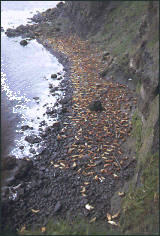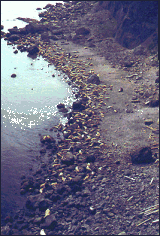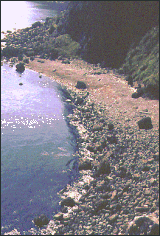 1969 |
 1979 |
 1986 |
| Steller sea lion population decline at Ugamak Island | ||
The number of Steller sea lions in the western stock declined by 75% between 1976 and 1990. The extent of this decline led the National Marine Fisheries Service (NMFS) to list the Steller sea lion as threatened range-wide under the Endangered Species Act (ESA) in April 1990. In the 1990s, the decline continued for the western stock in Alaska, which was declared endangered in 1997. The eastern stock, which has increased at about 3% per year since the 1980s, remains listed as threatened.
Many factors could have contributed to the decline of the western Steller sea lion stock in the 1980s and 1990s. These include factors that cause mortality directly, such incidental take in fisheries, illegal and legal shooting, predation or certain diseases, as well as other factors that indirectly would lead to population declines by reducing productivity. Such indirect factors include the effects of climate change or fisheries, which would alter prey abundance, distribution or species composition leading to nutritional stress, as well as the effects of certain diseases or contaminants. NMML, along with its research partners in the North Pacific, has been conducting research to determine how each of these factors may have affected sea lions in the past and may be currently affecting sea lion recovery. This research, summarized at http://alaskafisheries.noaa.gov/protectedresources/stellers/default.htm, involves investigations of Steller sea lion population dynamics, foraging ecology, physiology and biology, as well as studies of killer whales, climate change, fisheries impacts, sea lion diseases, and the distribution and effect of various pollutants.
In addition to research, NMFS has promulgated regulations on human activity to promote sea lion recovery. As part of the emergency rulemaking when Steller sea lions were first listed as threatened in 1990, NMFS prohibited shooting at or near Steller sea lions, reduced the number that could be killed incidental to fishing operations, and designated 3-mile no-entry zones around rookeries (breeding locations) in western Alaska to protect sea lions from disturbance. In 1992, under the authority of the Magnuson Fisheries Conservation and Management Act, NMFS established no-trawl zones around the same rookeries to protect sea lion prey resources. NMFS listed all rookeries, major haul-out sites, and aquatic feeding areas in the southeastern Bering Sea and in Shelikof Strait as Critical Habitat under the ESA in 1993. In 2001-2003, a complex suite of regulations to manage Steller sea lion and various groundfish fishery interactions were enacted, and a description of these regulations can be found on the National Marine Fisheries Service/Alaska Region website.

